Troy-Bilt Storm 2625, Storm 2420, Storm 2620, Storm 2890, Storm 3090 User Manual
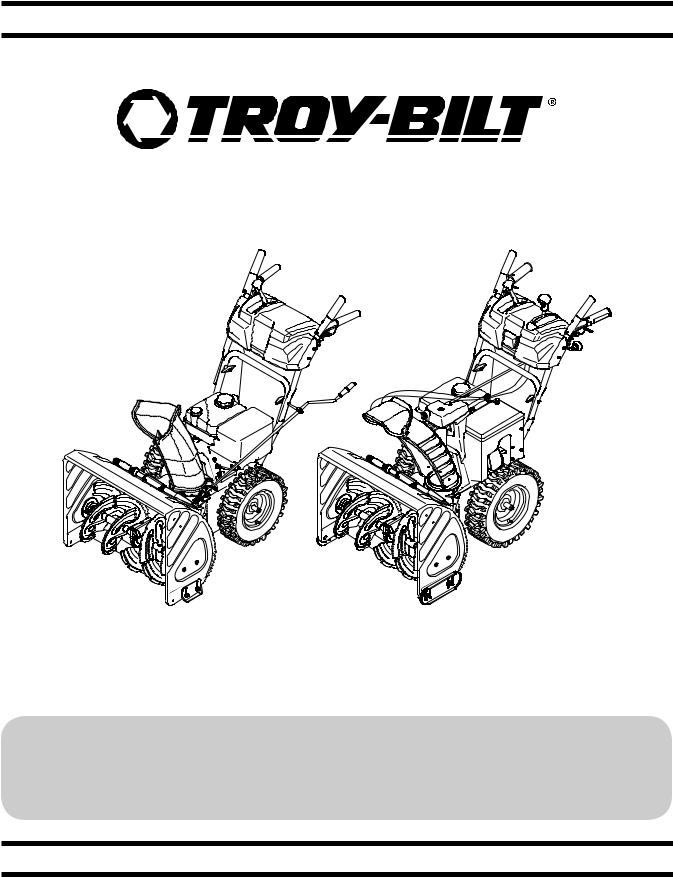
Safe Operation Practices • Set-Up • Operation • Maintenance • Service • Troubleshooting • Warranty
Operator’s Manual
Two-Stage Snow Thrower — Storm 2410, 2420, 2620, 2625, 2840, 2890, & 3090
 WARNING
WARNING
READ AND FOLLOW ALL SAFETY RULES AND INSTRUCTIONS IN THIS MANUAL
BEFORE ATTEMPTING TO OPERATE THIS MACHINE.
FAILURE TO COMPLY WITH THESE INSTRUCTIONS MAY RESULT IN PERSONAL INJURY.
TROY-BILT LLC, P.O. BOX 361131 CLEVELAND, OHIO 44136-0019
Printed In USA |
Form No. 769-09762 |
|
(May 29, 2014) |

To The Owner
Thank You
Thank you for purchasing a Troy-Bilt Snow Thrower. It was carefully engineered to provide excellent performance when properly operated and maintained.
Please read this entire manual prior to operating the equipment. It instructs you how to safely and easily set up, operate and maintain your machine. Please be sure that you, and any other persons who will operate the machine, carefully follow the recommended safety practices at all times. Failure to do so could result in personal injury or property damage.
All information in this manual is relative to the most recent product information available at the time of printing. Review this manual frequently to familiarize yourself with the machine, its features and operation. Please be aware that this Operator’s Manual may cover a range of product specifications for various models. Characteristics and features discussed and/or illustrated in this manual may not be applicable to all models. We reserve
1
the right to change product specifications, designs and equipment without notice and without incurring obligation.
If applicable, the power testing information used to establish the power rating of the engine equipped on this machine can be found at www.opei.org or the engine manufacturer’s web site.
If you have any problems or questions concerning the machine, phone a authorized Troy-Bilt service dealer or contact us directly. Troy-Bilt’s Customer Support telephone numbers, website address and mailing address can be found on this page. We want to ensure your complete satisfaction at all times.
Throughout this manual, all references to right and left side of the machine are observed from the operating position.
Table of Contents
Safe Operation Practices......................................... |
3 |
Service..................................................................... |
22 |
Assembly & Set-Up................................................... |
7 |
Troubleshooting..................................................... |
26 |
Controls.................................................................... |
14 |
Replacement Parts................................................. |
27 |
Operation................................................................ |
17 |
Attachments........................................................... |
28 |
Maintenance & Adjustment.................................. |
18 |
Warranty................................................... |
Back Cover |
Record Product Information |
Model Number |
|
|
|
|
|
|
|
|
|||||||||
Before setting up and operating your new equipment, please |
|
|
|
|
|
|
|
|
|
|
|
|
|
|
|
|
|
|
|
|
|
|
|
|
|
|
|
|
|
|
|
|
|
|
|
||
locate the model plate on the equipment and record the |
|
|
|
|
|
|
|
|
|
|
|
|
|
|
|
|
|
|
information in the provided area to the right. You can locate the |
|
|
|
|
|
|
|
|
|
|
|
|
|
|
|
|
|
|
|
|
|
|
|
|
|
|
|
|
|
|
|
|
|
|
|
||
model plate by standing at the operator’s position and looking |
Serial Number |
|
|
|
|
|
|
|
|
|||||||||
down at the rear of the frame. This information will be necessary, |
|
|
|
|
|
|
|
|
||||||||||
should you seek technical support via our web site, Customer |
|
|
|
|
|
|
|
|
|
|
|
|
|
|
|
|
|
|
|
|
|
|
|
|
|
|
|
|
|
|
|
|
|
|
|
||
Support Department, or with a local authorized service dealer. |
|
|
|
|
|
|
|
|
|
|
|
|
|
|
|
|
|
|
|
|
|
|
|
|
|
|
|
|
|
|
|
|
|
|
|
||
|
|
|
|
|
|
|
|
|
|
|
|
|
|
|
|
|
|
|
|
|
|
|
|
|
|
|
|
|
|
|
|
|
|
|
|
|
|
Customer Support
Please do NOT return the machine to the retailer or dealer without first contacting the Customer Support Department.
If you have difficulty assembling this product or have any questions regarding the controls, operation, or maintenance of this machine, you can seek help from the experts. Choose from the options below:
◊Visit us on the web at www.troybilt.com
See How-to Maintenance and Parts Installation Videos at www.troybilt.com/tutorials
◊Call a Customer Support Representative at (800) 828-5500 or (330) 558-7220
◊Write to Troy-Bilt LLC • P.O. Box 361131 • Cleveland, OH • 44136-0019
2
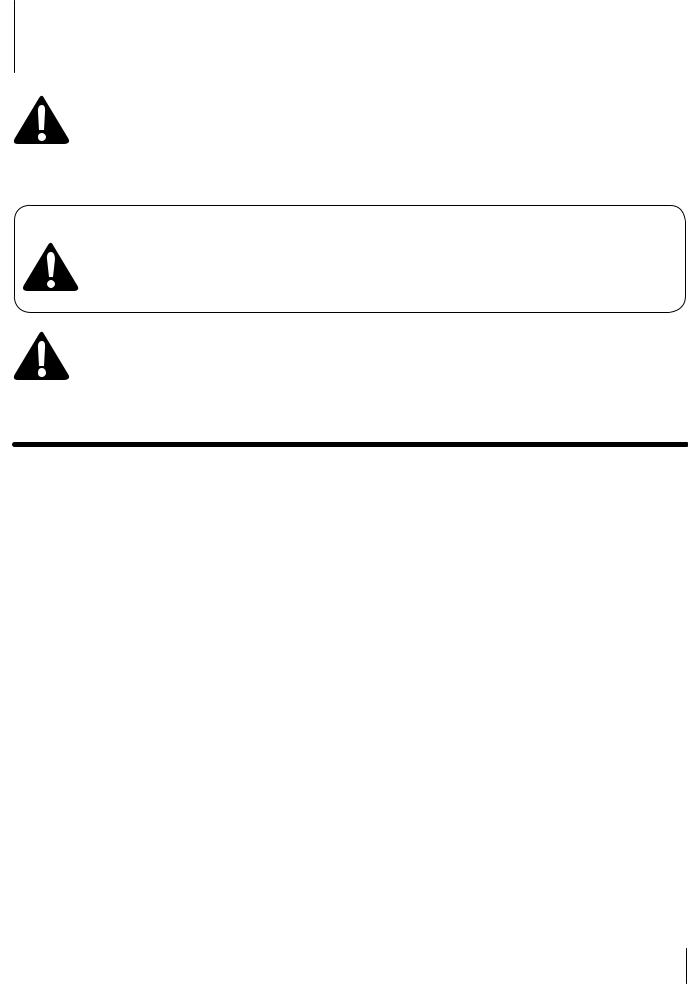
Important Safe Operation Practices |
2 |
|
|
|
|
WARNING! This symbol points out important safety instructions which, if not followed, could endanger the personal safety and/or property of yourself and others. Read and follow all instructions in this manual before attempting to operate this machine. Failure to comply with these instructions may result in personal injury.
When you see this symbol. HEED ITS WARNING!
CALIFORNIA PROPOSITION 65
WARNING! Engine Exhaust, some of its constituents, and certain vehicle components contain or emit chemicals known to State of California to cause cancer and birth defects or other reproductive harm.
DANGER: This machine was built to be operated according to the safe operation practices in this manual. As with any type of power equipment, carelessness or error on the part of the operator can result in serious injury. This machine is capable of amputating fingers, hands, toes and feet and throwing foreign objects. Failure to observe the following safety instructions could result in serious injury or death.
Training
1.Read, understand, and follow all instructions on the machine and in the manual(s) before attempting to assemble and operate. Keep this manual in a safe place for future and regular reference and for ordering replacement parts.
2.Be familiar with all controls and their proper operation. Know how to stop the machine and disengage them quickly.
3.Never allow children under 14 years of age to operate this machine. Children 14 and over should read and understand the instructions and safe operation practices in this manual and on the machine and be trained and supervised by an adult.
4.Never allow adults to operate this machine without proper instruction.
5.Thrown objects can cause serious personal injury. Plan your snow-throwing pattern to avoid discharge of material toward roads, bystanders and the like.
6.Keep bystanders, pets and children at least 75 feet from the machine while it is in operation. Stop machine if anyone enters the area.
7.Exercise caution to avoid slipping or falling, especially when operating in reverse.
Preparation
Thoroughly inspect the area where the equipment is to be used. Remove all doormats, newspapers, sleds, boards, wires and other foreign objects, which could be tripped over or thrown by the auger/impeller.
1.Always wear safety glasses or eye shields during operation and while performing an adjustment or repair to protect your eyes. Thrown objects which ricochet can cause serious injury to the eyes.
2.Do not operate without wearing adequate winter outer garments. Do not wear jewelry, long scarves or other loose clothing, which could become entangled in moving parts. Wear footwear which will improve footing on slippery surfaces.
3.Use a grounded three-wire extension cord and receptacle for all machines with electric start engines.
4.Adjust auger housing height to clear gravel or crushed rock surfaces.
5.Disengage all control levers before starting the engine.
6.Never attempt to make any adjustments while engine is running, except where specifically recommended in the operator’s manual.
7.Let engine and machine adjust to outdoor temperature before starting to clear snow.
3
Safe Handling of Gasoline
To avoid personal injury or property damage use extreme care in handling gasoline. Gasoline is extremely flammable and the vapors are explosive. Serious personal injury can occur when gasoline is spilled on yourself or your clothes which can ignite. Wash your skin and change clothes immediately.
a.Use only an approved gasoline container.
b.Extinguish all cigarettes, cigars, pipes and other sources of ignition.
c.Never fuel machine indoors.
d.Never remove gas cap or add fuel while the engine is hot or running.
e.Allow engine to cool at least two minutes before refueling.
f.Never over fill fuel tank. Fill tank to no more than ½ inch below bottom of filler neck to provide space for fuel expansion.
g.Replace gasoline cap and tighten securely.
h.If gasoline is spilled, wipe it off the engine and equipment. Move machine to another area. Wait 5 minutes before starting the engine.
i.Never store the machine or fuel container inside where there is an open flame, spark or pilot light (e.g. furnace, water heater, space heater, clothes dryer etc.).
j.Allow machine to cool at least 5 minutes before storing.
k.Never fill containers inside a vehicle or on a truck or trailer bed with a plastic liner. Always place containers on the ground away from your vehicle before filling.
l.If possible, remove gas-powered equipment from the truck or trailer and refuel it on the ground. If this is not possible, then refuel such equipment on a trailer with a portable container, rather than from a gasoline dispenser nozzle.
m.Keep the nozzle in contact with the rim of the fuel tank or container opening at all times until fueling is complete. Do not use a nozzle lock-open device.
Operation
1.Do not put hands or feet near rotating parts, in the auger/ impeller housing or chute assembly. Contact with the rotating parts can amputate hands and feet.
2.The auger/impeller control lever is a safety device. Never bypass its operation. Doing so makes the machine unsafe and may cause personal injury.
3.The control levers must operate easily in both directions and automatically return to the disengaged position when released.
4.Never operate with a missing or damaged chute assembly. Keep all safety devices in place and working.
5.Never run an engine indoors or in a poorly ventilated area. Engine exhaust contains carbon monoxide, an odorless and deadly gas.
6.Do not operate machine while under the influence of alcohol or drugs.
7.Muffler and engine become hot and can cause a burn. Do not touch. Keep children away.
8.Exercise extreme caution when operating on or crossing gravel surfaces. Stay alert for hidden hazards or traffic.
9.Exercise caution when changing direction and while operating on slopes. Do not operate on steep slopes.
10.Plan your snow-throwing pattern to avoid discharge towards windows, walls, cars etc. Thus, avoiding possible property damage or personal injury caused by a ricochet.
11.Never direct discharge at children, bystanders and pets or allow anyone in front of the machine.
12.Do not overload machine capacity by attempting to clear snow at too fast of a rate.
13.Never operate this machine without good visibility or light. Always be sure of your footing and keep a firm hold on the handles. Walk, never run.
14.Disengage power to the auger/impeller when transporting or not in use.
15.Never operate machine at high transport speeds on slippery surfaces. Look down and behind and use care when backing up.
16.If the machine should start to vibrate abnormally, stop the engine, disconnect the spark plug wire and ground it against the engine. Inspect thoroughly for damage. Repair any damage before starting and operating.
17.Disengage all control levers and stop engine before you leave the operating position (behind the handles). Wait until the auger/impeller comes to a complete stop before unclogging the chute assembly, making any adjustments, or inspections.
18.Never put your hand in the discharge or collector openings. Always use the clean-out tool provided to unclog the discharge opening. Do not unclog chute assembly while engine is running. Shut off engine and remain behind handles until all moving parts have stopped before unclogging.
19.Use only attachments and accessories approved by the manufacturer (e.g. wheel weights, tire chains, cabs etc.).
20.When starting engine, pull cord slowly until resistance is felt, then pull rapidly. Rapid retraction of starter cord
(kickback) will pull hand and arm toward engine faster than you can let go. Broken bones, fractures, bruises or sprains could result.
21.If situations occur which are not covered in this manual, use care and good judgment. Contact Customer Support for assistance and the name of your nearest servicing dealer.
4 |
|
Section 2 — Important Safe Operation Practices |
|
||
|
|
|

Clearing a Clogged Discharge Chute
Hand contact with the rotating impeller inside the discharge chute is the most common cause of injury associated with snow throwers. Never use your hand to clean out the discharge chute.
To clear the chute:
1.SHUT THE ENGINE OFF!
2.Wait 10 seconds to be sure the impeller blades have stopped rotating.
3.Always use a clean-out tool, not your hands.
Maintenance & Storage
1.Never tamper with safety devices. Check their proper operation regularly. Refer to the maintenance and adjustment sections of this manual.
2.Before cleaning, repairing, or inspecting machine disengage all control levers and stop the engine. Wait until the auger/impeller come to a complete stop. Disconnect the spark plug wire and ground against the engine to prevent unintended starting.
3.Check bolts and screws for proper tightness at frequent intervals to keep the machine in safe working condition. Also, visually inspect machine for any damage.
4.Do not change the engine governor setting or over-speed the engine. The governor controls the maximum safe operating speed of the engine.
5.Snow thrower shave plates and skid shoes are subject to wear and damage. For your safety protection, frequently check all components and replace with original equipment manufacturer’s (OEM) parts only. “Use of parts which do not meet the original equipment specifications may lead to improper performance and compromise safety!”
6.Check control levers periodically to verify they engage and disengage properly and adjust, if necessary. Refer to the adjustment section in this operator’s manual for instructions.
7.Maintain or replace safety and instruction labels, as necessary.
8.Observe proper disposal laws and regulations for gas, oil, etc. to protect the environment.
9.Prior to storing, run machine a few minutes to clear snow from machine and prevent freeze up of auger/impeller.
10.Never store the machine or fuel container inside where there is an open flame, spark or pilot light such as a water heater, furnace, clothes dryer etc.
11.Always refer to the operator’s manual for proper instructions on off-season storage.
12.Check fuel line, tank, cap, and fittings frequently for cracks or leaks. Replace if necessary.
13.Do not crank engine with spark plug removed.
14.According to the Consumer Products Safety Commission (CPSC) and the U.S. Environmental Protection Agency (EPA), this product has an Average Useful Life of seven (7) years,
or 60 hours of operation. At the end of the Average Useful Life have the machine inspected annually by an authorized service dealer to ensure that all mechanical and safety systems are working properly and not worn excessively. Failure to do so can result in accidents, injuries or death.
Do not modify engine
To avoid serious injury or death, do not modify engine in any way. Tampering with the governor setting can lead to a runaway engine and cause it to operate at unsafe speeds. Never tamper with factory setting of engine governor.
Notice Regarding Emissions
Engines which are certified to comply with California and federal EPA emission regulations for SORE (Small Off Road Equipment) are certified to operate on regular unleaded gasoline, and
may include the following emission control systems: Engine Modification (EM), Oxidizing Catalyst (OC), Secondary Air Injection (SAI) and Three Way Catalyst (TWC) if so equipped.
Spark Arrestor
WARNING! This machine is equipped with an internal combustion engine and should not be used on or near any unimproved forest-covered, brush covered or grass-covered land unless the engine’s exhaust system is equipped with a spark arrestor meeting applicable local or state laws (if any).
If a spark arrestor is used, it should be maintained in effective working order by the operator. In the State of California the above is required by law (Section 4442 of the California Public Resources Code). Other states may have similar laws. Federal laws apply on federal lands.
A spark arrestor for the muffler is available through your nearest engine authorized service dealer or contact the service department, P.O. Box 361131 Cleveland, Ohio 44136-0019.
Section 2 — Important Safe Operation Practices |
|
5 |
|
||
|
|
|
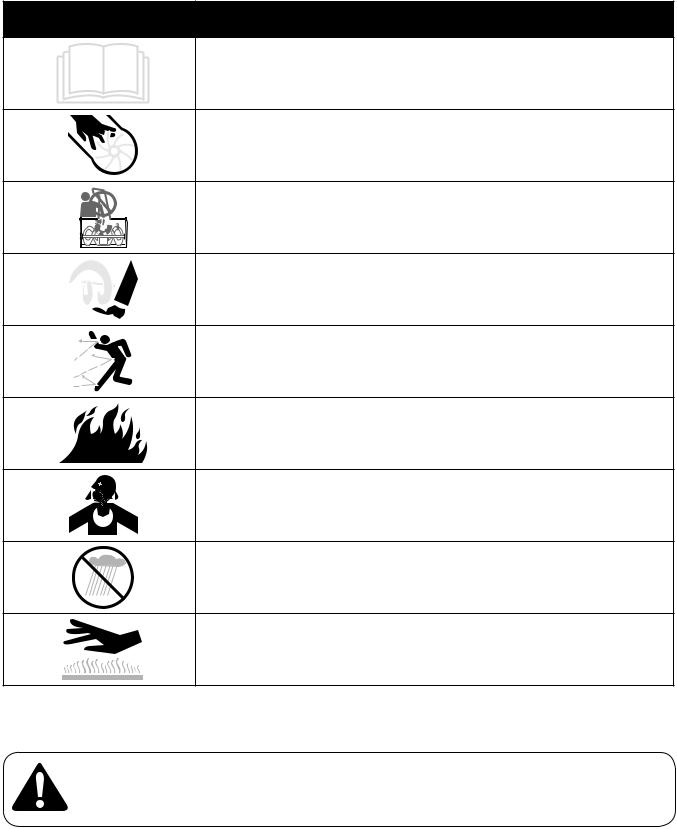
Safety Symbols
This page depicts and describes safety symbols that may appear on this product. Read, understand, and follow all instructions on the machine before attempting to assemble and operate.
Symbol |
Description |
READ THE OPERATOR’S MANUAL(S)
Read, understand, and follow all instructions in the manual(s) before attempting to assemble and operate
WARNING— ROTATING BLADES
Keep hands out of inlet and discharge openings while machine is running. There are rotating blades inside
WARNING— ROTATING BLADES
Keep hands out of inlet and discharge openings while machine is running. There are rotating blades inside
WARNING— ROTATING AUGER
Do not put hands or feet near rotating parts, in the auger/impeller housing or chute assembly. Contact with the rotating parts can amputate hands and feet.
WARNING—THROWN OBJECTS
This machine may pick up and throw objects which can cause serious personal injury.
WARNING—GASOLINE IS FLAMMABLE
Allow the engine to cool at least two minutes before refueling.
WARNING— CARBON MONOXIDE
Never run an engine indoors or in a poorly ventilated area. Engine exhaust contains carbon monoxide, an odorless and deadly gas.
WARNING— ELECTRICAL SHOCK
Do not use the engine’s electric starter in the rain
WARNING— HOT SURFACE
Engine parts, especially the muffler, become extremely hot during operation. Allow engine and muffler to cool before touching.
WARNING! Your Responsibility—Restrict the use of this power machine to persons who read, understand and follow the warnings and instructions in this manual and on the machine.
SAVE THESE INSTRUCTIONS!
6 |
|
Section 2 — Important Safe Operation Practices |
|
||
|
|
|
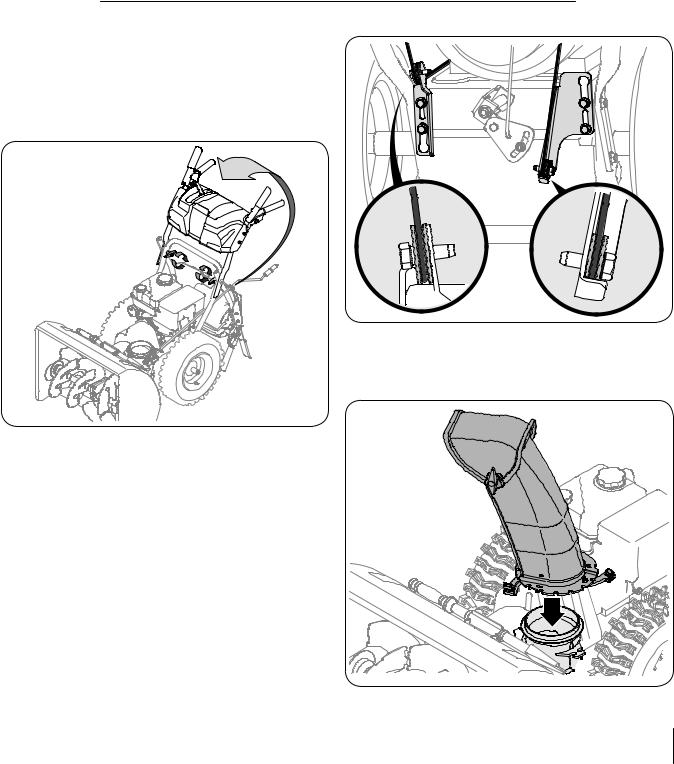
Assembly & Set-Up |
|
|
|
|
3 |
|
|
|
|
|
|
|
|
Contents of Carton |
|
|
|
|
|
|
• |
One Snow Thrower |
• |
Two Replacement Auger Shear Pins |
• |
One Chute Assembly |
|
• |
One Snow Thrower Operator’s |
• |
One Product Registration Card |
• |
One Chute Control Rod† |
|
|
Manual |
|
|
|
|
|
•One Engine Manual
†If Equipped
Assembly
Handle (All Models)
1. Place the shift lever in the Forward-6 position.
2.Observe the lower rear area of the snow thrower to be sure both cables are aligned with roller guides before pivoting
the handle upward. See Figure 3-1.
Figure 3-2
Chute Assembly (Model 2410)
1. Position the chute assembly over the base. See Figure 3-3.
Figure 3-1
NOTE: Make certain the cables are seated properly in the roller guides. See Figure 3-2.
3.Secure the handle by tightening the plastic knob located on both the left and right sides of the handle. Remove and discard any rubber bands, if present. They are for packaging purposes only.
Figure 3-3
7
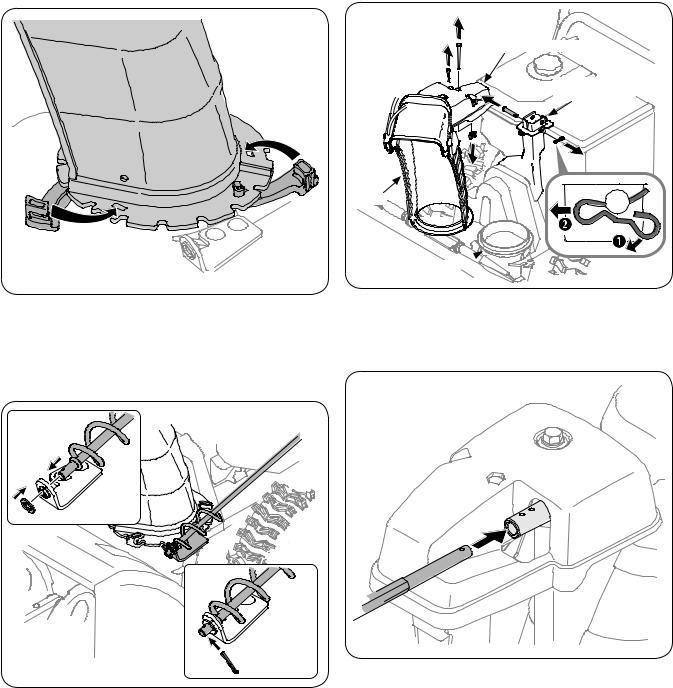
2.Close the flange keepers to secure the chute assembly to the chute base. The flange keepers will click into place when properly secure. See Figure 3-4.
NOTE: If the flange keepers will not easily click into place, use the palm of your hand to apply swift, firm pressure to the back of each.
Chute Assembly and Directional Control (Models 2420, 2620, 2625 and 2840)
1.Remove cotter pin, wing nut and hex screw from chute control head. Remove clevis pin and bow-tie cotter pin from chute support bracket. See Figure 3-6.
Figure 3-4
Chute Directional Control (Model 2410)
1.Remove the plastic cap (if present), flat washer and hairpin clip from the end of the chute directional control. See Figure 3-5.
Figure 3-5
2.Insert the end of the chute directional control into the lower bracket and secure with the flat washer and hairpin clip just removed. If necessary, the lower bracket can be adjusted. Refer to Chute Bracket Adjustment on Page 19.
Chute Control Head
Chute Support
Bracket
Chute
Chute Base 
Figure 3-6
2.Insert chute control rod into chute control head. Push rod as far into chute control head as possible, keeping the holes in the rod pointing upward. See Figure 3-7.
Figure 3-7
8 |
|
Section 3— Assembly & Set-Up |
|
||
|
|
|
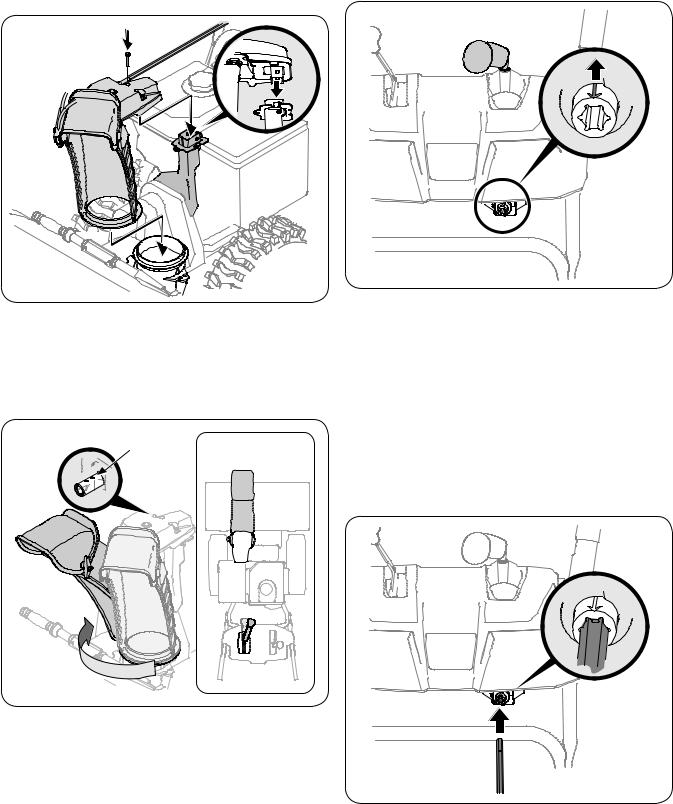
3.Place chute onto chute base and ensure chute control rod is positioned under the handle panel. Install hex bolt previously removed, but do not secure with wing nut at this time. See Figure 3-8.
5.Rotate the joystick to the one o’clock position so that the silver indicator arrow on the pinion gear below the control panel faces upward. See Figure 3-10.
Figure 3-8
4.Squeeze the trigger on the joystick and rotate the chute by hand to face forward. The holes in the chute control input will be facing up. See Figure 3-9.
NOTE: The chute will not rotate without squeezing the trigger on the joystick.
Chute Control |
Top View |
|
Input |
||
|
Figure 3-9
Figure 3-10
NOTE: The joystick will be angled slightly to the right at the one o’clock position. See “Top View” in Figure 3-9.
6.Insert the chute control rod into the pinion gear below the joystick. Make sure to line up the hole in the rod with the arrow on the pinion gear. See Figure 3-11.
NOTE: The chute control rod will fit snuggly into the pinion gear. Support the rear of the dash panel with one hand while inserting the rod with your other hand to ensure the rod is inserted all the way into the pinion gear.
NOTE: The hole is a reference for aligning the rod with the indicator arrow on the pinion gear, and will be visible after the rod has been inserted.
Figure 3-11
Section 3 — Assembly & Set-Up |
|
9 |
|
||
|
|
|
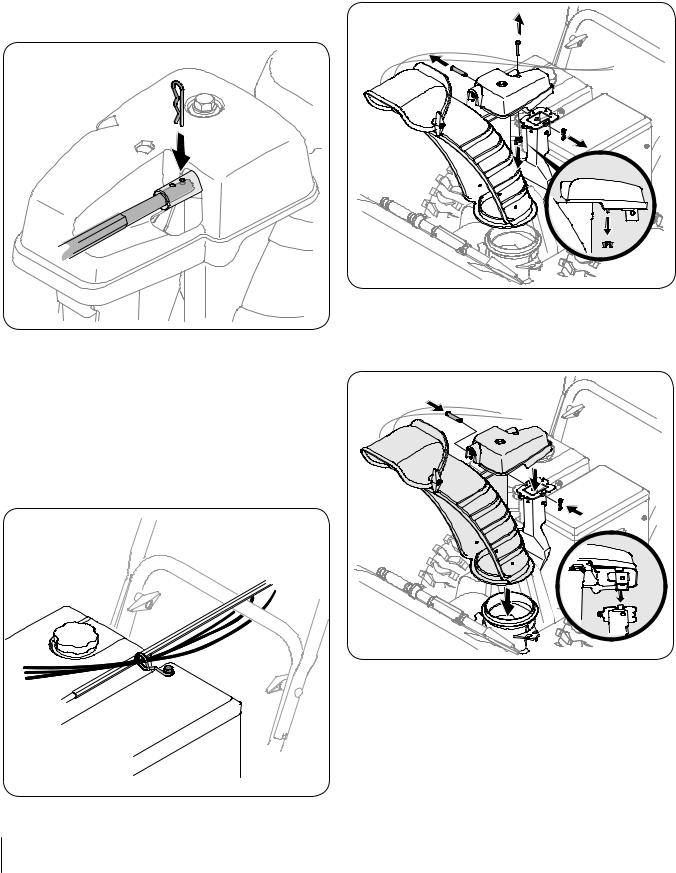
7.Push the chute control rod toward the control panel until the hole in the rod lines up with the hole in the chute control input closest to the chute control head and insert the cotter pin. See Figure 3-12.
NOTE: The second hole is used to achieve further engagement of the chute control rod into the pinion gear if required. Refer to page 19 for Chute Control Rod adjustments.
Figure 3-12
8.Finish securing chute control head to chute support bracket with wing nut, clevis pin, and bow-tie cotter pin removed in step 1. See Figure 3-6.
9.Check that the cables are properly routed through the cable guide on top of the engine. Some models only have one cable to route through the cable guide. See Figure 3-13.
NOTE: For smoothest operation, the cables should all be to the left of the chute directional control rod.
Figure 3-13
Overhead Chute Control Assembly (Models 2890 & 3090)
1.Remove wing nut and hex screw from chute control assembly and clevis pin and cotter pin from chute support bracket. Position the chute assembly (forward-facing) over the chute base. See Figure 3-14.
Figure 3-14
2.Place chute assembly onto chute base and secure chute control assembly to chute support bracket with clevis pin and cotter pin removed earlier. See Figure 3-15.
Figure 3-15
10 Section 3— Assembly & Set-Up
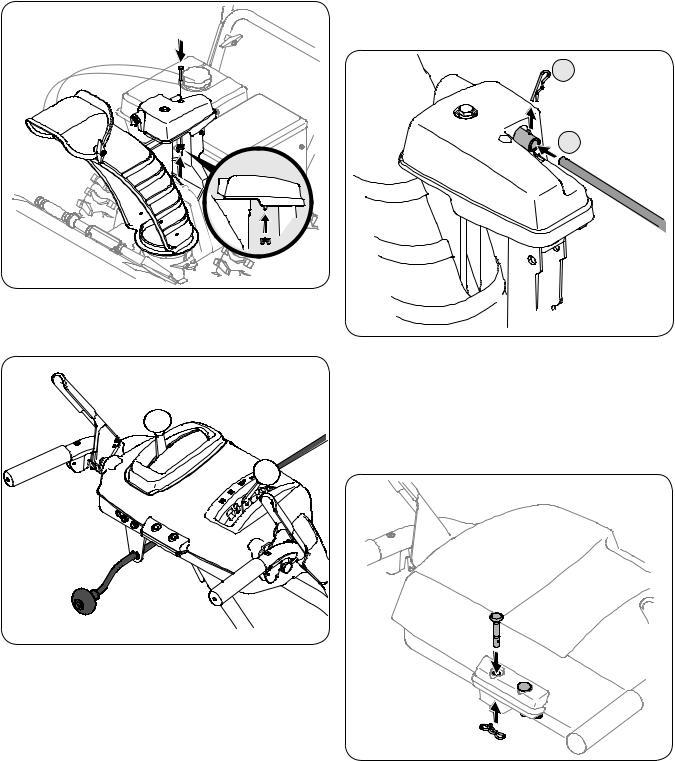
3.Finish securing chute control assembly to chute support bracket with wing nut and hex screw removed earlier. See Figure 3-16.
Figure 3-16
4.Insert the chute directional control rod into the support bracket on the rear of the dash panel. See Figure 3-17.
Figure 3-17
5.Remove the hairpin clip from the rear of the chute control assembly. See Figure 3-18a.
6.Insert chute directional control rod into rear of the chute control assembly. See Figure 3-18b. Secure the chute directional control rod to the chute control assembly with the hairpin clip removed earlier.
a
b
Figure 3-18
Set-Up
Shear Pins
A pair of replacement auger shear pins and bow tie cotter pins are included with your snow thrower. Store them in your snow thrower’s dash panel until needed. See Figure 3-19.
Figure 3-19
Section 3 — Assembly & Set-Up |
|
11 |
|
||
|
|
|
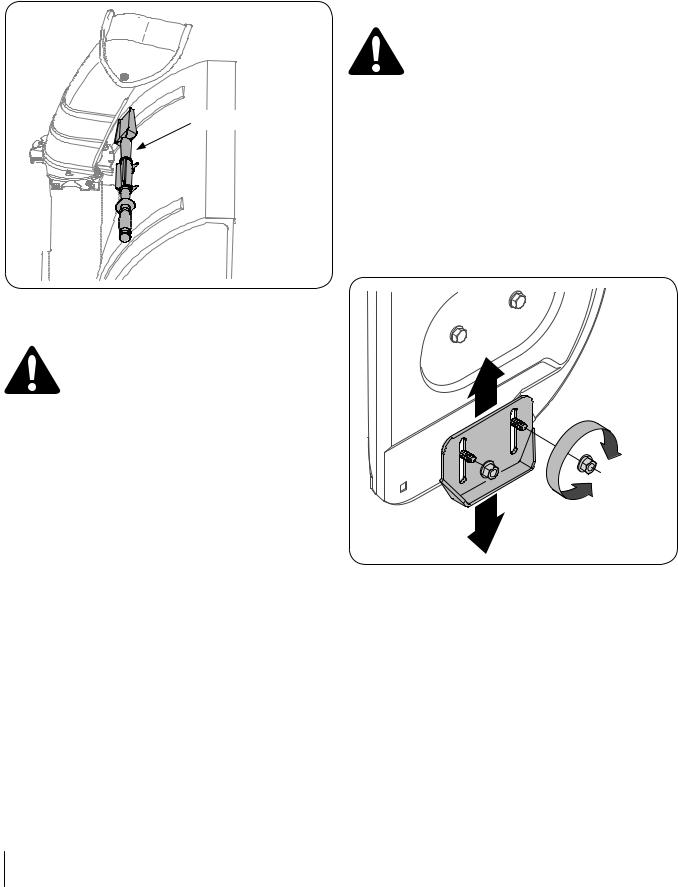
Chute Clean-Out Tool
The chute clean-out tool is fastened to the top of the auger housing with a mounting clip and a cable tie at the factory. Cut the cable tie before operating the snow thrower. See Figure 3-20.
Chute Clean-Out Tool
Adjustments
Skid Shoes
The snow thrower skid shoes are adjusted upward at the factory for shipping purposes. Adjust them downward, if desired, prior to operating the snow thrower.
CAUTION: It is not recommended that you operate this snow thrower on gravel as it can easily pick up and throw loose gravel, causing personal injury or damage to the snow thrower and surrounding property.
•For close snow removal on a smooth surface, raise skid shoes higher on the auger housing.
•Use a middle or lower position when the area to be cleared is uneven, such as a gravel driveway.
NOTE: If you choose to operate the snow thrower on a gravel surface, keep the skid shoes in position for maximum clearance between the ground and the shave plate.
To adjust the skid shoes:
1.Loosen the four hex nuts (two on each side) and carriage bolts. Move skid shoes to desired position. See Figure 3-21.
Figure 3-20
Tire Pressure
WARNING: Under any circumstance do not exceed manufacturer’s recommended psi. Equal tire pressure should be maintained at all times. Excessive pressure when seating beads may cause tire/rim assembly to burst with force sufficient to cause serious injury. Refer to side wall of tire for recommended pressure.
The tires are over-inflated for shipping purposes. Check the tire pressure before operating the snow thrower. Refer to the tire side wall for tire manufacturer’s recommended psi and deflate (or inflate) the tires as necessary.
NOTE: If the tire pressure is not equal in both tires, the machine may not travel in a straight path and the shave plate may wear unevenly.
NOTE: Standard skid shoes shown for illustration.
Figure 3-21
2.Make certain the entire bottom surface of skid shoe is against the ground to avoid uneven wear on the skid shoes.
3.Retighten nuts and bolts securely.
12 Section 3— Assembly & Set-Up

Chute Assembly (Models 2410, 2420, 2620 and 2625)
NOTE: The upper chute on model 2840 is also controlled by the 4-way Chute Directional Control. See Figure 4-1.
The distance snow is thrown can be adjusted by changing the angle of the chute assembly. To do so:
1.Stop the engine. Refer to the Engine Operator’s Manual. Remove the key from the engine and loosen the plastic knob found on the left side of the chute assembly.
2.Pivot the chute upward or downward before retightening the wing knob. See Figure 3-22.
Figure 3-22
3.Insert Key into engine and start engine. Refer to the Engine Operator’s manual.
Auger Control
WARNING! Prior to operating your snow thrower, carefully read and follow all instructions below. Perform all adjustments to verify your snow thrower is operating safely and properly.
Refer to the Controls and Features section for the location of the auger control and check the adjustment as follows:
1.When the auger control is released and in the disengaged “up” position, the cable should have very little slack. It should NOT be tight.
2.In a well-ventilated area, start the snow thrower engine. Refer to Engine Operator’s Manual.
3.While standing in the operator’s position (behind the snow thrower), engage the auger.
4.Allow the auger to remain engaged for approximately ten (10) seconds before releasing the auger control. Repeat this several times.
5.With the throttle control in the FAST (rabbit) position and the auger control in the disengaged “up” position, walk to the front of the machine.
6.Confirm that the auger has completely stopped rotating and shows NO signs of motion. If the auger shows ANY signs of rotating, immediately return to the operator’s position and shut off the engine. Wait for ALL moving parts to stop before re-adjusting the auger control.
7.To readjust the control cable, loosen the upper hex screw on the auger cable bracket. See Figure 3-23.
Figure 3-23
8.Position the bracket upward to provide more slack (or downward to increase cable tension).
9.Retighten the upper hex screw.
10.Repeat steps 2 through 6 above to verify proper adjustment has been achieved.
Section 3 — Assembly & Set-Up |
|
13 |
|
||
|
|
|
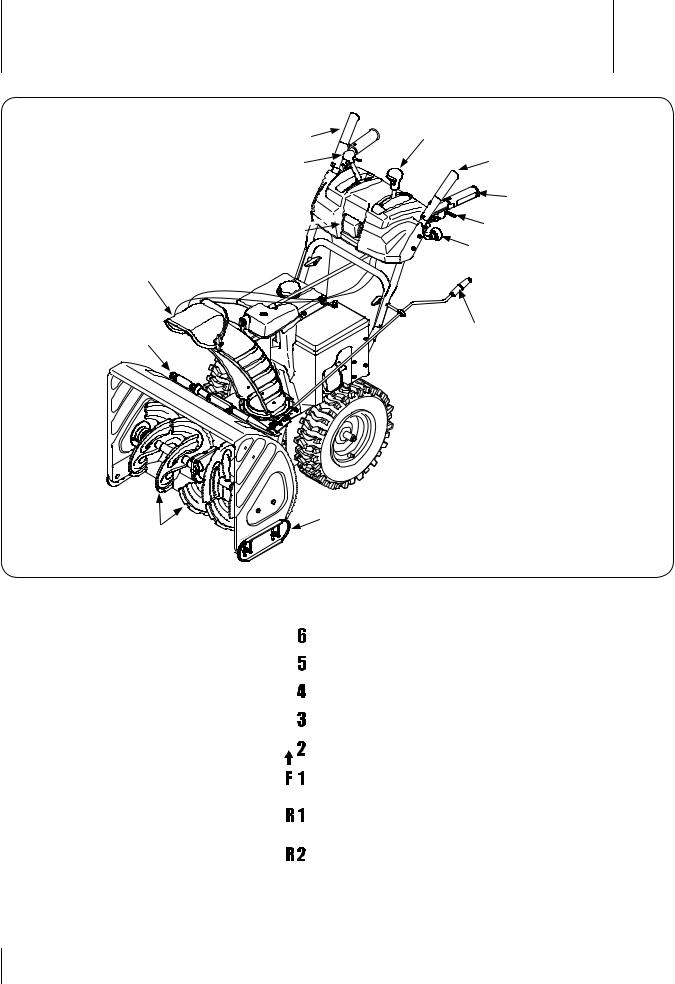
Controls and Features |
4 |
|
|
||
|
4-Way/2-Way Chute |
|
Drive Control |
Directional Control † |
|
|
||
Shift Lever |
Auger Control |
|
|
Heated Grips † |
|
Headlight † |
Steering Trigger † |
|
|
||
|
Overhead Chute |
|
Chute Assembly |
Directional Control † |
|
|
||
Chute Clean |
Standard Chute |
|
Out Tool |
||
Directional Control † |
||
|
Skid Shoe
Augers
† If Equipped
Figure 4-1
Snow thrower controls and features are described below and illustrated in Figure 4-1.
Shift Lever
The shift lever is located in the right side of the handle panel and is used to determine ground speed and direction of travel.
Forward
There are six forward (F) speeds. Position one (1) is the slowest and position six (6) is the fastest.
Reverse
There are two reverse (R) speeds. One (1) is the slower and two (2) is the faster.
Skid Shoes
Position the skid shoes based on surface conditions. Adjust upward for hard-packed snow. Adjust downward when operating on gravel or crushed rock surfaces. See Set-Up & Assembly section. Skid shoe styles and appearance vary by model.
Augers
When engaged, the augers rotate and draw snow into the auger housing.
Chute Assembly
Snow drawn into the auger housing is discharged out the chute assembly. Chute assembly styles and appearance vary by model.
Headlight (If so equipped)
The headlight is located on top of the handle panel and is automatically turned on when the engine is started.
14
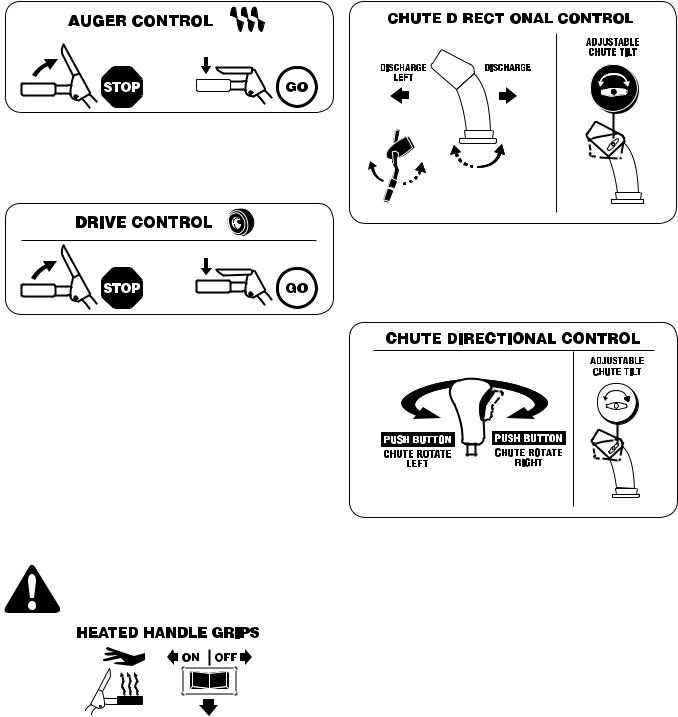
Auger Control |
|
|
|
|
|
|
|
|
|
|
|
|
Standard Chute Directional Control (If so equipped) |
||||||
|
|
|
|
|
|
|
|
|
|
|
|
|
|
|
|
|
|
|
|
|
|
|
|
|
|
|
|
|
|
|
|
|
|
|
|
|
|
|
|
|
|
|
|
|
|
|
|
|
|
|
|
|
|
|
|
|
|
|
|
|
|
|
|
|
|
|
|
|
|
|
|
|
|
|
|
|
|
|
|
The auger control is located on the left handle. Squeeze the control grip against the handle to engage the augers and start snow throwing action. Release to stop.
Drive Control / Auger Clutch Lock (If so equipped)

 T
T
The chute directional control is located on left side of the snow thrower. To change the direction in which snow is thrown, rotate chute directional control.
2-Way Chute Directional Control (If so equipped)
The drive control is located on the right handle. Squeeze the control grip against the handle to engage the wheel drive. Release to stop.
On select models, the drive control also locks the auger control so that you can operate the chute directional control without interrupting the snow throwing process. If the auger control is engaged simultaneously with the drive control, the operator can release the auger control (on the left handle) and the augers will remain engaged. Release both controls to stop the augers and wheel drive.
NOTE: Always release the drive control before changing speeds. Failure to do so will result in increased wear on your machine’s drive system.
Heated Grips (If so equipped)
CAUTION: It is recommended that you wear gloves when using the heated grip. If the heated grip becomes too hot, turn it off.
To activate the heated grips, move the switch found on the rear of the dash panel into the ON position. To turn off the heated grips, move the switch found on the rear of the dash panel to the OFF position.
The 2-way chute directional control is located on the left side of the dash panel.
•To change the direction in which snow is thrown, squeeze the button on the joy-stick and pivot the joy-stick to the right or to the left.
Section 4 — Controls and Features |
|
15 |
|
||
|
|
|
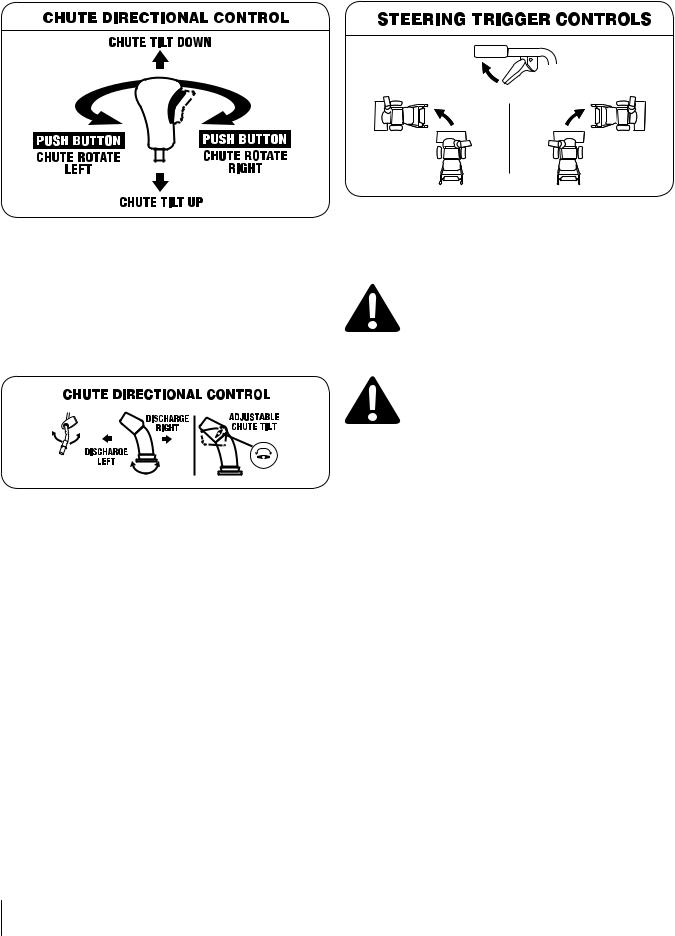
4-Way Chute Directional Control (If so equipped)
The 4-way chute directional control is located on the left side of the dash panel.
•To change the direction in which snow is thrown, squeeze the button on the joy-stick and pivot the joy-stick to the right or to the left.
•To change the angle/distance which snow is thrown, pivot the joy-stick forward or backward.
Overhead Chute Directional Control (If so Equipped)
The overhead chute directional control is located in the center of the snow thrower between the handle panel and lower handle. To change the direction in which snow is thrown, rotate the chute directional control.
Steering Trigger Controls (If so equipped)
The left and right wheel steering trigger controls are located on the underside of the handles.
•Squeeze the right control to turn right.
•Squeeze the left control to turn left.
CAUTION: Operate the snow thrower in open areas until you are familiar with these controls.
Chute Clean-Out Tool
WARNING! Never use your hands to clear a clogged chute assembly. Shut off engine and remain behind handles until all moving parts have stopped before unclogging.
The chute clean-out tool is conveniently fastened to the rear of the auger housing with a mounting clip. Should snow and ice become lodged in the chute assembly during operation, proceed as follows to safely clean the chute assembly and chute opening:
1.Release both the Auger Control and the Drive Control.
2.Stop the engine. Refer to the Engine Operator’s Manual. Remove the key.
3.Remove the clean-out tool from the clip which secures it to the rear of the auger housing.
4.Use the shovel-shaped end of the clean-out tool to dislodge and scoop any snow and ice which has formed in and near the chute assembly.
5.Refasten the clean-out tool to the mounting clip on the rear of the auger housing, reinsert the key and start the snow thrower’s engine.
While standing in the operator’s position (behind the snow thrower), engage the auger control for a few seconds to clear any remaining snow and ice from the chute assembly.
16 Section 4 — Controls and Features
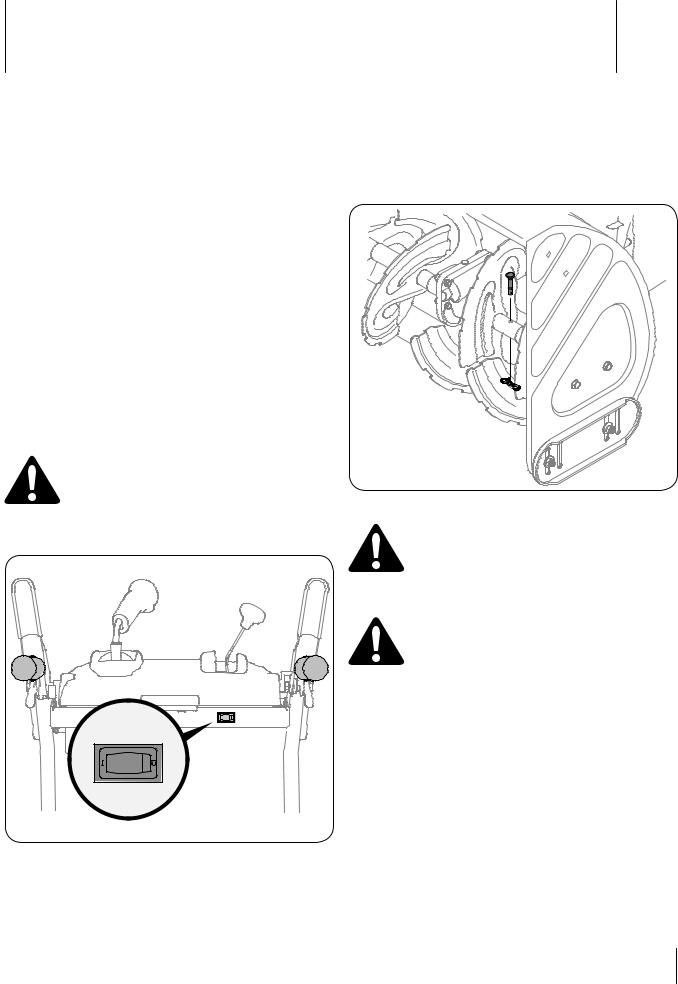
Operation
Starting and Stopping the Engine
Refer to the Engine Operator’s Manual packed with your snow thrower for instructions on starting and stopping the engine.
To Engage Drive
1.With the throttle control in the Fast (rabbit) position, move shift lever into one of the six forward (F) positions or two reverse (R) positions. Select a speed appropriate for the snow conditions and a pace you’re comfortable with.
2.Squeeze the drive control against the handle the snow thrower will move. Release it and drive motion will stop.
To Engage Augers
To engage the augers and start throwing snow, squeeze the auger control against the left handle. Release to stop the augers.
To Steer (Models equipped with steering trigger controls)
With the drive control engaged, squeeze the right steering trigger control to turn right. Squeeze the left steering trigger control to turn left.
Heated Grips (If so equipped)
CAUTION: It is recommended that you wear gloves when using the heated grip. If the heated grip becomes too hot, turn it off.
To activate the heated grips, move the switch found on the rear of the dash panel into the ON position. See Figure 5-1.
Figure 5-1
5
Replacing Shear Pins
The augers are secured to the spiral shaft with shear pins and bow-tie cotter pins. If the auger should strike a foreign object or ice jam, the snow thrower is designed so that the pins may shear. If the augers will not turn, check to see if the pins have sheared. See Figure 5-2.
Figure 5-2
CAUTION: NEVER replace the auger shear pins with anything other than OEM Part No. 738-04124A replacement shear pins. Any damage to the auger gearbox or other components as a result of failing to do so will NOT be covered by your snow thrower’s warranty.
WARNING! Always turn off the snow thrower’s engine and remove the key prior to replacing shear pins.
17
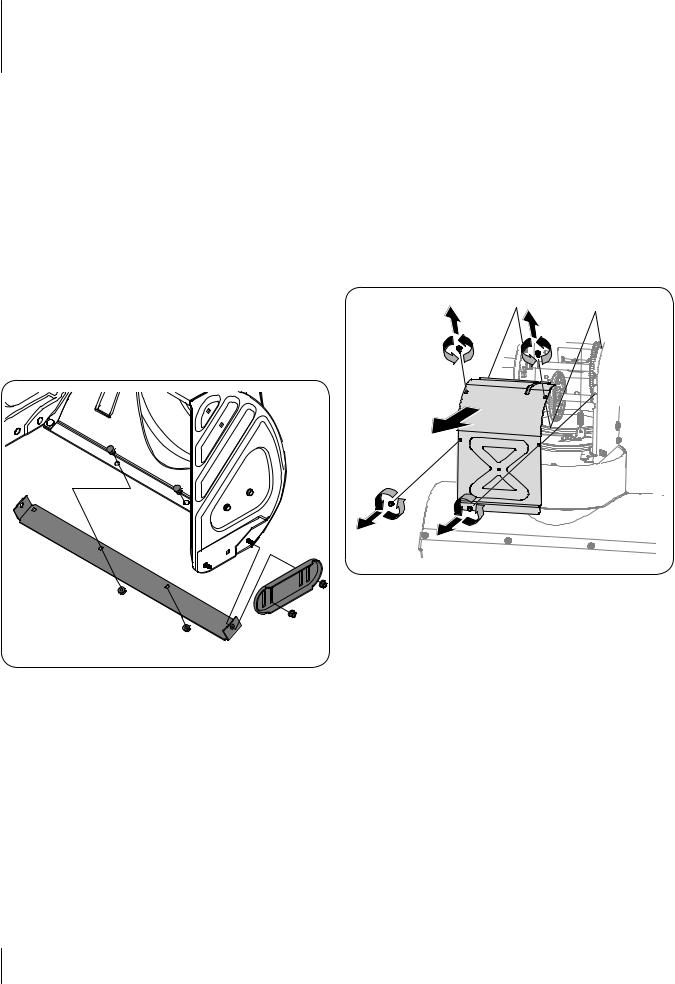
Maintenance & Adjustments |
6 |
|
|
|
|
Maintenance
Engine
Refer to the Engine Operator’s Manual.
Shave Plate and Skid Shoes
The shave plate and skid shoes on the bottom of the snow thrower are subject to wear. They should be checked periodically and replaced when necessary.
NOTE: Deluxe skid shoes (on select models) have two wear edges. When one side wears out, they can be rotated 180° to use the other edge.
To remove skid shoes:
1.Remove the four carriage bolts and hex flange nuts which secure them to the snow thrower.
2.Reassemble new skid shoes with the four carriage bolts (two on each side) and hex flange nuts. Refer to Figure 6-1.
NOTE: Augers not shown for clarity
Figure 6-1
To remove shave plate:
1.Remove the carriage bolts and hex nuts which attach it to the auger housing.
2.Reassemble new shave plate, making sure heads of carriage bolts are to the inside of housing. Tighten securely.
Tire Pressure
Refer to page 11 for information regarding tire pressure.
Lubrication
Gear Shaft
The gear (hex) shaft should be lubricated at least once a season or after every twenty-five (25) hours of operation.
1.Allow the engine to run until it is out of fuel.
2.Carefully pivot the snow thrower up and forward so that it rests on the auger housing.
3.Remove the frame cover from the underside of the snow thrower by removing the self-tapping screws which secure it. See Figure 6-2.
Figure 6-2
18
